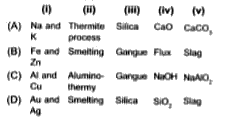Roasting is carried out in extraction of metal in how many ores/minerals?
Chalcopyrite, magnetite, Cassiterite containing impurity of pyrites of Fe and Cu, Galena, Zinc blende, Siderite,
The correct Answer is:6
CuFeS2+O2→Cu2S+FeO+SO2↑
[Fe3O4+O4→Fe2O3,
FeCO3+O2→Fe2O3+CO2]
FeO conversion into Fe2O3 to prevent losss of iron in form of slag (FeSiO3)
SnO2+O2→ No reaction
FeSCu2S}+O2→sulphate, removed by treating with hotH2O
Pbs+O2→PbO+SO2
ZnS+O2→ZnO+SO2
Topper's Solved these Questions
- BOOK - ALLENCHAPTER - TEST PAPERSEXERCISE - CHEMISTRY19videos
TEST PAPERS
- BOOK - ALLENCHAPTER - TEST PAPERSEXERCISE - part-2 Chemisty18videos
TEST PAPERS
- BOOK - ALLENCHAPTER - TEST PAPER 4EXERCISE - CHEMISTRY45videos
TEST PAPER 4
- BOOK - ALLENCHAPTER - THERMODYNAMICS EXERCISE - EXERCISE -418videos
THERMODYNAMICS
Similar Questions
Amongest the following, how many ores are roasted to convert them into their corresponding metal oxides, alumina, zinc blende, iron pyrites, copper pyrites, galena.
View SolutionFind out the number of minerals given below which contain iron as Fe(II).
Haematite, Magnetite, Limonite, Siderite, Chromite, WolframiteView Solution
Knowledge Check
- Question 1 - Select One
All minerals are not ore but all ores are minerals. The extraction of a particular metal depends upon several factor and overall it has to be convenitent and economical. Following common steps are involved in extraction of metal from its prime ore:
(a) Pulverisation
(b) Concentration
(c) Calcination/Roasting
(d) Smelting and Reduction
(e) Purifaction of crude metal
Which of the following options is correct? State true and false
(P) Fe2O3 can be reduced by coke as well as aluminium.
(Q) Red bauxite is is concentrated by leaching method.
(R ) Impure Zn is purified by either distilation or electrolytic is refining method.
(S ) Wrought iron is a purest form of iron.ATTTTBFTTTCFTFTDTFTF - Question 2 - Select One
Read the given passage carefully and fill in the blanks by selecting an appropriate option.
Oxides of (i) –––––– are reduced to their respective metals by heating with coke and the process is called (ii) –––––––. Before carrying out reduction with carbon, if the calcined or roasted ore still contains infusible impurities of earthy matter, called (iii) ––––––––, an additional substance, called (iv) –––––––– is added which combines with (iii) to form a fusible material, called (v) –––––––. AABBCCDD
AABBCCDD - Question 3 - Select One
Consider the following statements . Roasting is carried out to :
(i) convert sulphide to oxide and sulphate.
(ii) to remove impurities of CuS and FeS present in the ore of tin stone (SnO2) as CuSO4 and FeSO4.
(iii) melt the ore.
(iv) remove arsenic and sulphur impurities.
of these statements.A(i),(ii) and (iii) are correctB(ii),(iii) and (iv) are correct.C(i),(ii) and (iv) are correct.D(i),(ii),(iii),(iv) are correct.
How many of the following involves carbon reduction during extraction of metal from ore ?
Bauxite →Al⇒Copper pyrites→Cu
Haematile →Fe⇒Galena →Pb
Camallite →Mg⇒Sylvine→K
Cassiterite →Sn⇒Zinc blende→Zn
Silica → Si ⇒View SolutionHow many of the following ores contain Silver?
Hornsilver, Cerrusite, Chalcopyrite, Galena, Anglesite, ArgentiteView SolutionAmongst the followings the ores which are roasted to convert them into their corresponding metal oxides are :
alumina, zinc blende, iron pyrites, copper pyrites, calamine, galena, chalcocite.View SolutionConsider the following ores: Haematite, Magnetite, Siderite, Iron pyrites. How many of above ores can be concentrated by magnetic separation method?
View SolutionMinerals from which metals can be extracted economically and easily are called ores. The extraction of metals from theirs ores involves the following processes.
(i) Concentration
(ii) Calcination |roasting | leaching (iii) Reduction. It is carried out by one of the following methods.
(a) Carbon |carbon monoxide reduction. (b) Self reduction. (c) Electrolytic reduction. (d) Reduction by more electropositiv metal (i.e displacement method).
Which of the following reaction does not occur in Bessener converter in the extraction of copper from chalcopyrites.View Solution

